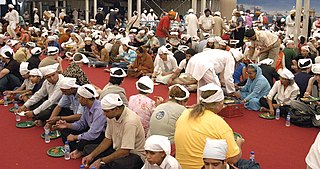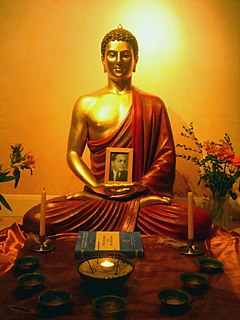Related Research Articles

India, officially the Republic of India, is a country in South Asia. It is the second-most populous country, the seventh-largest country by land area, and the most populous democracy in the world. Bounded by the Indian Ocean on the south, the Arabian Sea on the southwest, and the Bay of Bengal on the southeast, it shares land borders with Pakistan to the west; China, Nepal, and Bhutan to the north; and Bangladesh and Myanmar to the east. In the Indian Ocean, India is in the vicinity of Sri Lanka and the Maldives; its Andaman and Nicobar Islands share a maritime border with Thailand, Myanmar and Indonesia.

The Philippines, officially the Republic of the Philippines, is an archipelagic country in Southeast Asia. It is situated in the western Pacific Ocean, and consists of about 7,640 islands, that are broadly categorized under three main geographical divisions from north to south: Luzon, Visayas, and Mindanao. The Philippines is bounded by the South China Sea to the west, the Philippine Sea to the east, and the Celebes Sea to the southwest, and shares maritime borders with Taiwan to the north, Japan to the northeast, Palau to the east and southeast, Indonesia to the south, Malaysia and Brunei to the southwest, Vietnam to the west, and China to the northwest. The Philippines covers an area of 300,000 km2 (120,000 sq mi) and, as of 2020, had a population of around 109 million people, making it the world's twelfth-most populous country. The Philippines is a multinational state, with diverse ethnicities and cultures throughout its islands. Manila is the nation's capital, while the largest city is Quezon City, both lying within the urban area of Metro Manila.

Vastu shastra is a traditional Indian system of architecture originating in India. Texts from the Indian subcontinent describe principles of design, layout, measurements, ground preparation, space arrangement, and spatial geometry. Vastu Shastras incorporate traditional Hindu and Buddhist beliefs. The designs aim to integrate architecture with nature, the relative functions of various parts of the structure, and ancient beliefs utilising geometric patterns (yantra), symmetry, and directional alignments.

In Sikhism, a langar is the community kitchen of a gurdwara, which serves meals to all free of charge, regardless of religion, caste, gender, economic status, or ethnicity. People sit on the floor and eat together, and the kitchen is maintained and serviced by Sikh community volunteers. The meals served at a langar are always vegetarian.

The Dalit Buddhist movement is a religious as well as a socio-political movement among Dalits in India which was started by B. R. Ambedkar. It radically re-interpreted Buddhism and created a new school of Buddhism called Navayana. The movement has sought to be a socially and politically engaged form of Buddhism.

Pahela Baishakh or mor commonly known as Pohela Boishakh in Bangladesh and Poila Boishakh in the Indian states of West Bengal, Tripura, Assam and parts of Jharkhand is the first day of the Bengali calendar which is also the official calendar of Bangladesh. This festival is celebrated on 14 April in Bangladesh and 15 April in the Indian states of West Bengal, Tripura, and Assam by Bengalis regardless of religious faith.

The Vietnamese people or Kinh people are a Southeast Asian ethnic group originally native to modern-day Northern Vietnam and South China. The native language is Vietnamese, the most widely spoken Austroasiatic language. Although the Vietnamese language is Austroasiatic in origin, it was heavily sinicized throughout history and its vocabulary was influenced by Chinese.
Conservative liberalism is a variant of liberalism, combining liberal values and policies with conservative stances, or simply representing the right wing of the liberal movement. It is a more positive and less radical variant of classical liberalism.

The Buddha has been important to Hinduism since the ancient times. Regional Hindu texts over the centuries have presented a spectrum of views on Buddhism, possibly reflecting the competition between Buddhism and the Brahmanical traditions. In the Vaishnavism sect of Hinduism, the historic Buddha or Gautama Buddha, is the ninth avatar among the ten major avatars of the god Vishnu. In contemporary Hinduism the Buddha is revered by Hindus who usually consider "Buddhism to be another form of Hinduism". Similarly, other Hindus reject the identification of Gautama Buddha as an avatar of Vishnu, referring to the texts of the Puranas and identifying the two as different individuals.

Hinduism in Uganda arrived when the colonial British Empire brought Hindus along with other Indian workers to its East African colonies in late 19th and early 20th centuries. The largest arrival of Hindu immigrants to Uganda, some educated and skilled but mostly poor and struggling from the famine-prone areas of Punjab and Gujarat, was to help construct the Kenya-Uganda Railway connecting landlocked parts of Uganda and Kenya with the port city of Mombasa. The largest departure of Hindus from Uganda occurred when General Idi Amin expelled them and seized their properties in 1972.

Navayana means "new vehicle" and refers to the re-interpretation of Buddhism by Bhimrao R. Ambedkar; it is also called Neo-Buddhism, and Bhimayāna. Ambedkar was born in a Dalit (untouchable) family during the colonial era of India, studied abroad, became a Mahar Dalit leader, and announced in 1935 his intent to convert from Hinduism to Buddhism. Thereafter Ambedkar studied texts of Buddhism, found several of its core beliefs and doctrines such as Four Noble Truths and "non-self" as flawed and pessimistic, then re-interpreted these into what he called "new vehicle" Buddhism, or Navayana. Ambedkar held a press conference on 13 October 1956, announcing his rejection of Theravada and Mahayana Buddhism, as well as of Hinduism. Thereafter, he left Hinduism and adopted Navayana, about six weeks before his death. Its adherents see Navayana Buddhism not as a sect with radically different ideas, but rather as new movement founded on the principles of Buddhism.

The Bruneian Empire or Empire of Brunei, also known as Sultanate of Brunei, was a Malay sultanate, centred in Brunei on the northern coast of Borneo island in Southeast Asia. Bruneian rulers converted to Islam around the 15th century, when it grew substantially since the fall of Malacca to the Portuguese, extending throughout coastal areas of Borneo and the Philippines, before it declined in the 17th and 18th centuries.

The Indian subcontinent, or simply the subcontinent, is a physiographical region in South Asia. It is situated on the Indian Plate and projecting southwards into the Indian Ocean from the Himalayas. Geopolitically, the Indian subcontinent generally includes Bangladesh, Bhutan, India, Nepal, Pakistan and Sri Lanka, as well as Maldives. Geologically, the Indian subcontinent is related to the landmass that rifted from the supercontinent Gondwana during the Cretaceous and merged with the Eurasian landmass nearly 55 million years ago. Geographically, it is the peninsular region in South-Central Asia, delineated by the Himalayas in the north, the Hindu Kush in the west, and the Arakanese in the east. The terms Indian subcontinent and South Asia are sometimes used interchangeably to denote the region, although the term South Asia usually also includes Afghanistan.

South Asia is the southern region of Asia, which is defined in both geographical and ethno-cultural terms. The region consists of the countries of Afghanistan, Bangladesh, Bhutan, India, Nepal, Pakistan, Sri Lanka and the Maldives. Topographically, it is dominated by the Indian Plate and defined largely by the Indian Ocean on the south, and the Himalayas, Karakoram, and Pamir mountains on the north. The Amu Darya, which rises north of the Hindu Kush, forms part of the northwestern border. On land (clockwise), South Asia is bounded by Western Asia, Central Asia, East Asia, and Southeast Asia.

The Jat people also pronounced Jutt are a traditionally agriculture based community largely in rural parts of Northern India and Pakistan. Originally pastoralists in the lower Indus river-valley of Sindh, Jats migrated north into the Punjab region in late medieval times by the thirteenth century, and subsequently into the Delhi Territory, northeastern Rajputana, and the western Gangetic Plain in the 17th and 18th centuries. Of Hindu, Muslim and Sikh faiths, they are now found mostly in the Indian states of Punjab, Haryana, Rajasthan and Uttar Pradesh and the Pakistani provinces of Sindh and Punjab.

Various Urdu-speaking people are spread across South Asia. The vast majority of native Urdu-speakers are Muslims of the Urdu Belt of Northern India, followed by the Deccani people of the Deccan plateau in south-central India and the Muhajir people of Pakistan.
Shengjing Times, also known as Shengjing Shibao, usually abbreviated SJSB, was a Japanese-owned Chinese newspaper established in Fengtian on October 18, 1906 by Japanese journalist named Nakajima Masao (中島真雄). It received financial assistance from Japan's consulate-general in Fengtian during its early years.
China Business Herald, also known as Zhongguo Shangbao, is a national economic newspaper published in simplified Chinese in the People's Republic of China. The newspaper was inaugurated in Beijing on January 1, 1985, and its predecessor was China Commercial Newspaper (中国商业报).
References
- ↑ A. F. Salahuddin Ahmed (1965). Social Ideas and Social Change in Bengal 1818-1835. Brill Archive. pp. 88–89. GGKEY:8YWY14NBR66. Retrieved 9 May 2020.
- ↑ Michael S. Dodson; Brian A. Hatcher (28 February 2013). Trans-Colonial Modernities in South Asia. Routledge. pp. 78–. ISBN 978-1-136-48445-2 . Retrieved 9 May 2020.
- ↑ Sushil Chaudhury (13 September 2016). Trade, Politics and Society: The Indian Milieu in the Early Modern Era. Taylor & Francis. pp. 212–. ISBN 978-1-351-99728-7 . Retrieved 9 May 2020.
- ↑ Jacqueline Suthren Hirst; John Zavos (1 March 2013). Religious Traditions in Modern South Asia. Taylor & Francis. pp. 224–. ISBN 978-1-136-62667-8 . Retrieved 9 May 2020.
- ↑ Kunal Chakrabarti; Shubhra Chakrabarti (22 August 2013). Historical Dictionary of the Bengalis. Scarecrow Press. pp. 333–. ISBN 978-0-8108-8024-5 . Retrieved 9 May 2020.